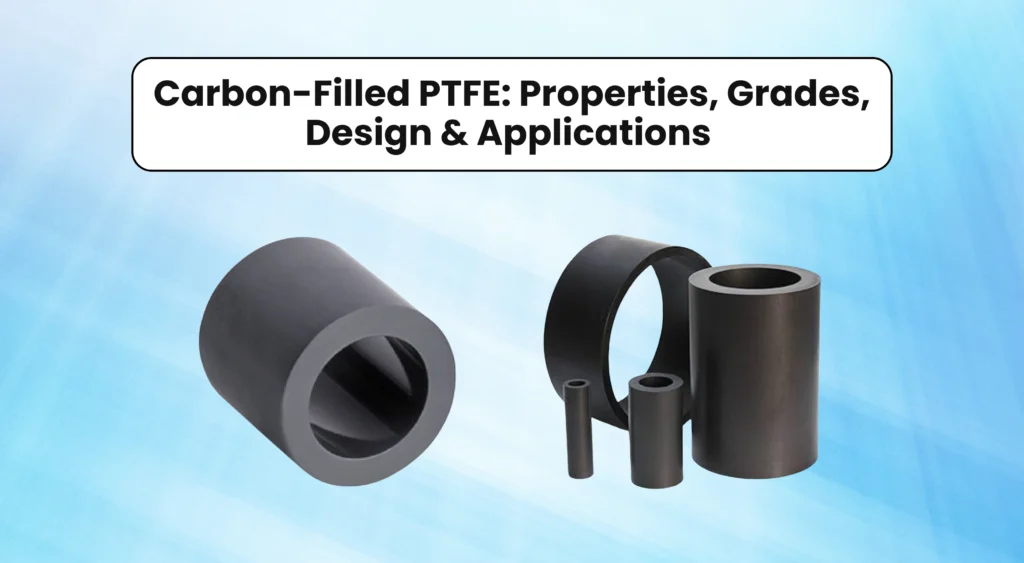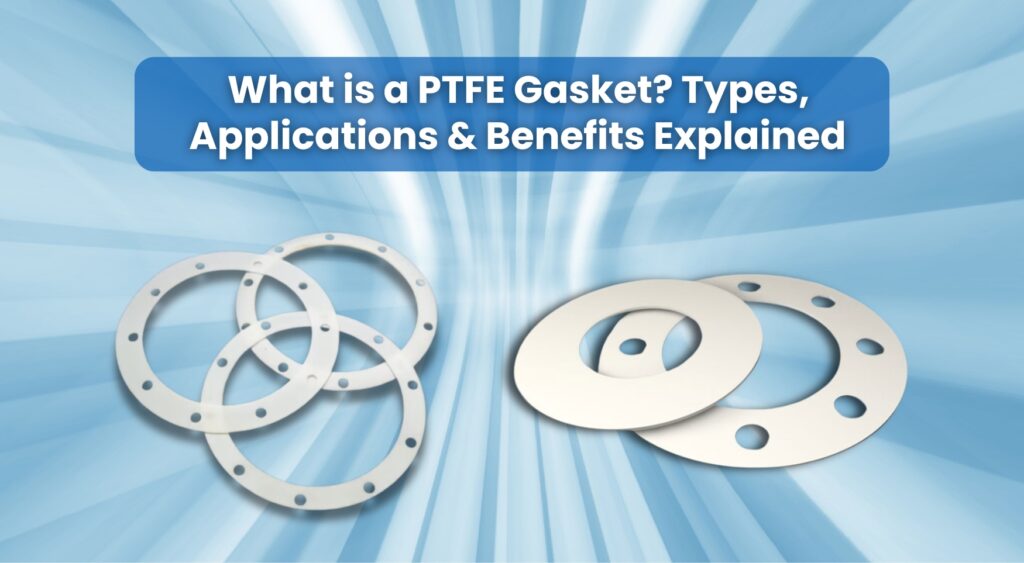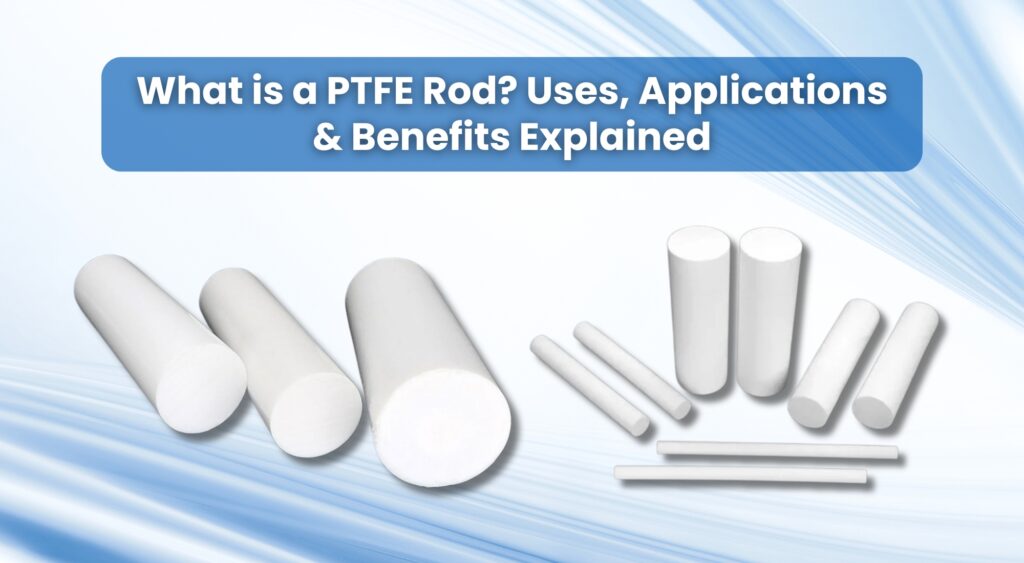Complete Guide to Carbon-Filled PTFE: Properties, Grades, Design & Applications
PTFE (Polytetrafluoroethylene) is famous for its greaseproof, glassy, and chemically resistant properties. When carbon (in powder or fibre form) is added to PTFE, it becomes Carbon-Filled PTFE, which is stronger, more durable, and better at managing heat and electrical conductivity. This guide delivers a comprehensive overview of carbon-filled PTFE, covering its properties, grades, design considerations, and industrial applications.
What Is Carbon-Filled PTFE?
- PTFE (Polytetrafluoroethylene) is a polymer known for being extremely slippery (low friction), chemically resistant, and able to work in very cold and very hot conditions.
- When you add carbon particles or fill PTFE, a composite material that blends PTFE’s core benefits (non-stick, chemical resistance, temperature tolerance) with extra performance in strength, wear resistance, dimensional stability, and in some cases, electrical or thermal conductivity.
- Hindustan Polymer describes their carbon-filled PTFE as “PTFE product with carbon-filled PTFE produced by loading carbon particles of various amounts into PTFE to obtain proper strength, conductivity, and durability.”
To explore more about its manufacturing and performance, you can also check out our Carbon-Filled PTFE Product Range designed for seals, bushings, and valve components in industrial applications.
Carbon-Filled PTFE Key Properties
Let’s see the main properties of carbon-filled PTFE, how they compare, and what you should keep in mind.
Mechanical & Wear Properties
- Adding carbon filler increases compressive strength, hardness, and local capacitance, and reduces deformation under load (creep).
- Coefficient of friction remains low, though sometimes slightly higher than ultra-pure PTFE.
- Dimensional stability under heat and pressure improves, thanks to the filler restricting movement.
Thermal & Electrical Properties
- Thermal conductivity improves when carbon filler is present (carbon conducts heat better than the polymer matrix).
- Electrical conductivity/antistatic behaviour: Carbon filler can impart “static dissipative” or antistatic characteristics (unlike pure PTFE, which is a very good insulator).
- Temperature service range remains wide: e.g., some carbon-filled PTFE can operate from -200°C up to +260-280°C.
Chemical & Environmental Resistance
- Good chemical resistance: Because PTFE is inherently chemically inert, adding carbon does not generally degrade that. Many carbon-filled grades still resist most industrial chemicals.
- Low moisture absorption, stable under many environmental conditions.
- Dimensional stability: Filler helps reduce expansion and creep, so parts hold shapes better under load or heat.
Other Practical Attributes
- Machinability: Carbon-filled PTFE can often be machined to a closer tolerance than virgin PTFE because it is stiffer/harder.
- Lubrication: The self-lubricating nature of PTFE remains, so sliding parts benefit from less sticking and less friction.
- Non-stick: The non-stick character of PTFE remains largely intact.
- Density: Usually higher than virgin PTFE because of the filler (carbon has a higher density). So the composite is heavier.
Popular Carbon-Filled PTFE Grades
- PTFE with 25% Carbon: Most common, suitable for seals, rings, bushings, bearings, and valves for both static and dynamic applications.
- PTFE with 23% Carbon + 2% Graphite: Better extrusion and wear resistance, ideal for high-performance seals and compressor rings.
- The type of carbon filler may vary, could be amorphous carbon powder, graphite carbon, carbon fibres, each giving different performance trade-offs (e.g., stronger but possibly slightly higher friction; more conductive; tougher).
For a better understanding of how these grades differ from unfilled PTFE, read our detailed comparison: Virgin PTFE vs. Carbon-Filled PTFE Thrust Pads.
Design Recommendations
- Use carbon-filled PTFE for static or dynamic seal rings in high-pressure and high-temperature applications.
- For better wear life, consider adding graphite for ultra-low friction and improved dry running.
- Opt for carbon fibre-fill for the highest mechanical strength and extrusion resistance in demanding environments.
- Avoid using carbon-filled grades in settings where the highest purity or white colour is mandatory.
Typical Application of Carbon-Filled PTFE
- Oil & Gas valves and rotary seals
- Rider and piston rings for air compressors
- Shaft and slid bearings in high-speed chemical pumps.
- Bushing, PTFE washers, and chemical tank linings need enhanced durability.
- Critical electronic or medical device parts require antistatic behaviour.
Advantages Over Virgin Carbon-Filled PTFE
- Much lower wear rate under load and friction.
- Improved conductivity prevents static buildup dangerous to sensitive electronics or flammable environments.
- Extends the lifetime of the seal and mechanical parts in aggressive service conditions, resulting in lower maintenance costs.
For detailed insight into PTFE standards and specifications, refer to ASTM D4894 – Standard Specification for PTFE Resin, which provides international guidelines on PTFE material properties.
Common Application & Use Cases of Carbon-Filled PTFE
Here are some of the major areas where carbon-filled PTFE shines:
Seals & Gaskets:
- Dynamic seals in hydraulic/pneumatic systems: the improved wear resistance and low friction of carbon-filled PTFE make it ideal.
- Static or high-pressure PTFE gaskets where creep and deformation need to be minimised.
- Chemical processing seals: Because of chemical resistance + enhanced mechanical stability.
Bearings and Bushings:
- Carbon-filled PTFE’s low wear rate and self-lubricating nature make it perfect for bearings, thrust washers, and bushings that operate without external lubrication.
- The stiffness and wear resistance of carbon-filled PTFE help maintain clearance and reduce friction.
Valve Seats and Rings:
- Common in pumps and valves, where it provides reliable sealing and long life even under constant motion and exposure to chemicals.
- The combination of low friction + high load capability helps reduce power loss and increase lifespan.
Electrical and Electronic Applications:
- Because it dissipates static charges, carbon-filled PTFE is used in electronic connectors, sensor components, and insulation parts.
- Parts in electronic equipment that see friction, but also need to avoid static build-up.
Conclusion
Carbon-filled PTFE is a remarkable engineering material that combines the chemical resistance of PTFE with the mechanical strength and conductivity of carbon. It offers enhanced durability, heat resistance, and dimensional stability, making it ideal for industries where reliability and performance are critical.
From seals and bearings to valve components and electrical systems, carbon-filled PTFE ensures long-lasting performance under tough conditions. Whether you’re designing for chemical processing, automotive, or aerospace, this material provides the perfect balance of strength, stability, and self-lubrication.
When you choose carbon-filled PTFE, you’re choosing a material built for efficiency, longevity, and exceptional engineering value.
Frequently Asked Questions (FAQs)
What is carbon-filled PTFE made of?
Carbon-filled PTFE is made by blending pure PTFE resin with carbon-based fillers like carbon powder, graphite, or carbon fibres. Sometimes, small amounts of glass fibre or graphite are added for extra strength and wear resistance. The result is a tough, heat-conductive, and chemical-resistant material ideal for seals, bearings, bushings, and valve components used in demanding industrial environments.
How is carbon-filled PTFE different from virgin PTFE?
Virgin PTFE is smooth, flexible, and highly chemical-resistant but soft and prone to deformation under stress. Carbon-filled PTFE, on the other hand, is stronger, more wear-resistant, and better at conducting heat. It’s also semi-conductive, unlike virgin PTFE, which is a full insulator.
These upgrades make carbon-filled PTFE ideal for industrial, automotive, and electrical applications that demand high durability and stability.
Is carbon-filled PTFE electrically conductive?
Yes. Unlike virgin PTFE, which is a strong insulator, carbon-filled PTFE is semi-conductive. The carbon particles create a conductive path within the material, helping it dissipate static electricity and prevent charge buildup. This antistatic property makes it ideal for electronic, electrical, and explosive environments, where static discharge can cause damage or safety issues. It’s commonly used in sensors, connectors, and grounding components for reliable performance.
Can carbon-filled PTFE be used with chemicals?
Yes. Carbon-filled PTFE maintains the chemical resistance and corrosion protection of pure PTFE. It can handle acids, bases, solvents, and harsh chemicals without degrading, making it ideal for chemical plants, pump linings, gaskets, and seals exposed to aggressive fluids.
What is the temperature range of carbon-filled PTFE?
Carbon-filled PTFE works reliably across a wide temperature range, typically from -200°C to +260°C, and up to +280°C in special grades. The carbon filler improves thermal conductivity and stability, allowing parts to handle high heat and pressure without deformation. It’s ideal for aerospace, automotive, and chemical processing applications.
Can carbon-filled PTFE be machined?
Yes, carbon-filled PTFE can be machined easily with standard tools like lathes and drills. It’s slightly harder than virgin PTFE, so sharp tools and proper speeds are recommended for smooth results. Its rigidity allows precise machining for custom parts like rings, bushings, and seals, while its self-lubricating nature ensures smooth movement and excellent wear performance even in dry conditions.
Is it food-safe or medical-grade?
No, carbon-filled PTFE is not food or medical-grade because carbon fillers may cause contamination or discolouration. For such uses, virgin PTFE or glass-filled PTFE is preferred since they meet FDA and medical standards and offer the same non-stick and chemical resistance with higher purity.



